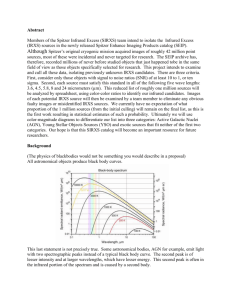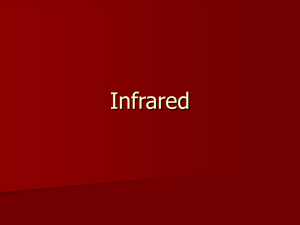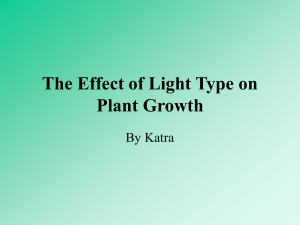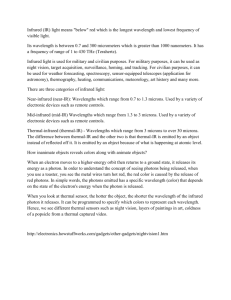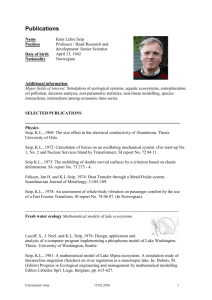Blue Objects for Kepler Observing (BOKO)
advertisement
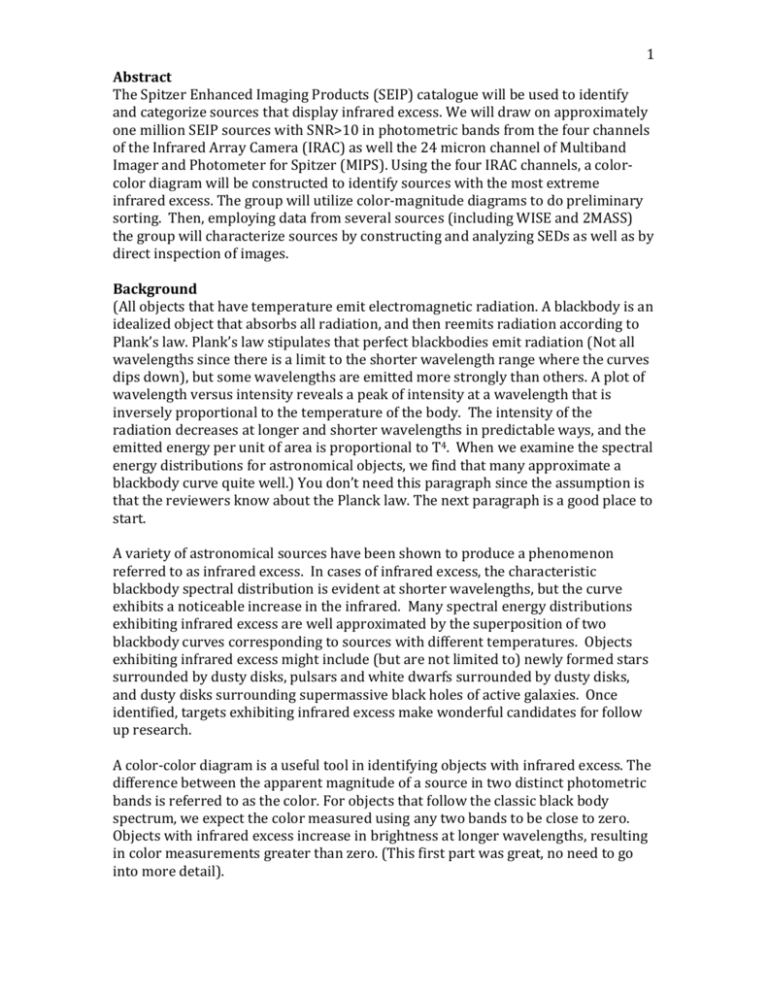
1 Abstract The Spitzer Enhanced Imaging Products (SEIP) catalogue will be used to identify and categorize sources that display infrared excess. We will draw on approximately one million SEIP sources with SNR>10 in photometric bands from the four channels of the Infrared Array Camera (IRAC) as well the 24 micron channel of Multiband Imager and Photometer for Spitzer (MIPS). Using the four IRAC channels, a colorcolor diagram will be constructed to identify sources with the most extreme infrared excess. The group will utilize color-magnitude diagrams to do preliminary sorting. Then, employing data from several sources (including WISE and 2MASS) the group will characterize sources by constructing and analyzing SEDs as well as by direct inspection of images. Background (All objects that have temperature emit electromagnetic radiation. A blackbody is an idealized object that absorbs all radiation, and then reemits radiation according to Plank’s law. Plank’s law stipulates that perfect blackbodies emit radiation (Not all wavelengths since there is a limit to the shorter wavelength range where the curves dips down), but some wavelengths are emitted more strongly than others. A plot of wavelength versus intensity reveals a peak of intensity at a wavelength that is inversely proportional to the temperature of the body. The intensity of the radiation decreases at longer and shorter wavelengths in predictable ways, and the emitted energy per unit of area is proportional to T4. When we examine the spectral energy distributions for astronomical objects, we find that many approximate a blackbody curve quite well.) You don’t need this paragraph since the assumption is that the reviewers know about the Planck law. The next paragraph is a good place to start. A variety of astronomical sources have been shown to produce a phenomenon referred to as infrared excess. In cases of infrared excess, the characteristic blackbody spectral distribution is evident at shorter wavelengths, but the curve exhibits a noticeable increase in the infrared. Many spectral energy distributions exhibiting infrared excess are well approximated by the superposition of two blackbody curves corresponding to sources with different temperatures. Objects exhibiting infrared excess might include (but are not limited to) newly formed stars surrounded by dusty disks, pulsars and white dwarfs surrounded by dusty disks, and dusty disks surrounding supermassive black holes of active galaxies. Once identified, targets exhibiting infrared excess make wonderful candidates for follow up research. A color-color diagram is a useful tool in identifying objects with infrared excess. The difference between the apparent magnitude of a source in two distinct photometric bands is referred to as the color. For objects that follow the classic black body spectrum, we expect the color measured using any two bands to be close to zero. Objects with infrared excess increase in brightness at longer wavelengths, resulting in color measurements greater than zero. (This first part was great, no need to go into more detail). 2 Since the discovery of dust around Vega using infrared excess in 1983, infrared excess has been used to detect a wide variety of interesting objects. Young stars enshrouded in dust, along with pulsars and white dwarfs surrounded by dusty disks display infrared excess (Not that you should have done this yet but we’ll eventually need to put in references here). Active Galactic Nuclei (AGNs) also tend to display infrared excess when the central black hole is surrounded by a dusty disk; as gas flows onto the black hole, it heats up the dusty disk, which in turn glows in the infrared. Colliding galaxies present yet another class of interesting objects with infrared excess. As the galaxies collide, a burst of star formation results in an object that is very bright in the infrared. The resulting object is referred to as an Ultra Luminous IR Galaxy (ULIRG). In some cases, evolved stars like red giants exhibit significant IR excess. These stars tend to create significant dust in their winds that reprocesses light from the star, resulting in infrared excess. Investigation of source list from the SEIP will likely turn up a variety of objects in each of the categories described above that are worthy of follow-up study. Given the ambitious sample size, it is also likely that extreme sources of infrared excess will be identified that may not fit neatly into previously defined categories. The new SEIP catalogue presents an opportunity to search for infrared excess in a large sample of objects. Our goals will be to determine what fraction of our sample exhibits infrared excess and to categorize as many sources as possible. In addition, we expect to develop statistical profile of the sample. By determining how frequently various types of objects occur in the sample, we will be able to set expectations for the future. In particular, we expect to help inform expectations about the James Webb Space Telescope (JWSS) mission. Like Spitzer, JWSS will not survey the entire sky, and instead will point at particular objects. (Do we refer to this as a “pointed” mission? Yes) The results of this study should indicate what scientists might hope to find in a comparable investigation of serendipitous JWSS targets. Scientific Goals The SEIP catalogue, released by the Spitzer Heritage Archive in (when was it released? Latest version was January of 2014), includes photometric measurements on all Spitzer sources imaged in the four Infrared Array Camera (IRAC) channels, as well the 24 micron channel of Multiband Imager and Photometer for Spitzer (MIPS). The majority of sources included in the catalogue were not primary imaging targets. Instead, their serendipitous placement in the field of the Spitzer Space Telescope has resulted in a (Can’t use the word “complete” since it has a very specific scientific meaning which the SEIP does not satisfy, just say) large set of photometric measurements. The SEIP likely contains a treasure trove of as yet unidentified infrared excess sources. The goal of our study is to identify and characterize these sources. We intend to: 1. Collect photometric data on approximately one million sources imaged in five bands and with SNR>10. 2. Generate color-color diagrams of [5.8-8.0] versus [3.6-4.5] for these sources. 3 3. Use the color-color diagram to identify the significant sources of infrared excess. 4. Select and characterize some portion of the these sources by generating color magnitude diagrams for the sample, producing SEDs for particular objects, and inspecting images for particular objects. 5. Draw conclusions about demographics of the sample. Timeframe March to July 2012 Develop color-color diagram, select objects with most extreme infrared excess, generate SEDs and inspect visual images to make a preliminary determination regarding the nature of each source. This may be a bit too ambitious July 2012 Meet as a group in Pasadena to compare data analysis, discuss results, and draw conclusions. August to December 2012 Finalize analysis and conclusions and prepare presentation for the AAS meeting in January. Expected Outcomes We expect to uncover a significant number of infrared excess sources contained in the SEIP catalogue. (Can this be made more concrete? We’ll work on this) To the extent possible, we will categorize these sources and make the results available to encourage follow-up investigations. In addition, we expect to develop statistical profile of our sample. By determining how frequently various types of objects occur, we will be able to set expectations for finding serendipitous infrared excess sources in similar samples in the future. Archived Data Our initial sample will come from the SEIP catalogue, which includes photometric data from several sources including the Spitzer Satellite, The Wide-field Infrared Survey Explorer (WISE), and the 2 Micron All Sky Survey (2MASS). Follow-up investigations may employ infrared data from a variety of sources. We do not expect to use optical or shorter wavelength photometric measurements. Instruments and Programs The Spitzer Satellite is an orbiting observatory with two infrared instruments relevant to the SIRXS project. The Infrared Array Camera (IRAC) images simultaneously in four wavelengths (3.6µm, 4.5 µm, 5.8µm and 8.0 µm). The Multiband Imaging Photometer for Spitzer (MIPS) includes a 24µm detector. The Wide-field Infrared Survey Explorer (WISE) is a satellite observatory that surveyed the entire sky in four wavelengths; 3.4µm, 4.6 µm, 12 µm, and 22 µm. The Two Micron All-Sky Survey (2MASS) was a ground based program that surveyed the entire sky in three wavelengths (1.25µm, 1.65 µm, and 2.17 µm). 4 Observations were obtained at Mount Hopkins, Arizona (Northern Hemisphere), and Cerro Tololo Inter-American Observatory, Chile (Southern Hemisphere). Educational Goals Caroline Odden intends to: 1. Host an afternoon workshop at Phillips Academy for astronomy teachers from the greater Boston area (September 2014). The will be to present the various ways in which students at Phillips Academy engage in astronomy research. The workshop will include presentations from Caroline and her students, conversation over dinner, and a visit to the Phillips Academy Observatory. The NITARP program and SIRXS project will be highlighted. 2. Present at the Phillips Academy Science Symposium. Students involved with the SIRXS project will present their methods and findings at the annual Phillips Academy Science Symposium (Spring 2015). A student led poster session is followed by a series of presentations from students on their research projects. The event is open to the entire school community. 3. Revise the Phillips Academy astronomy curriculum to reflect the NITARP experience. Specific topics, such as blackbody radiation, will be infused with concrete examples derived from the NITARP experience. The research course will include an introduction to the public archives, proposal writing, and presenting results in the form of a poster. As a mentor teacher, Caroline hopes to gain the skills to continue working on projects of this type with her students in the future. 4. Give presentations to local alumni, perspective parents and students, and other local groups such elementary school groups. As the supervisor of the campus observatory campus, Caroline is called upon to give presentations on a regular basis. She will take advantage of these events to talk about NITARP and will involve her students in the presentations when possible. 5. Present at American Association of Physics Teachers Meeting (Summer 2015). Recognizing student demand for research experiences, Caroline will submit a proposal to present at the AAPT summer meeting. She will describe the SIRXS project, discuss her experience with exposing high school students to authentic astronomy research, and provide information about how to participate in NITARP.

